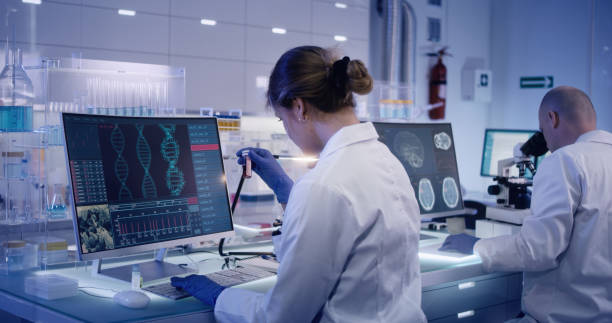
Genetic mutations are the basis of variation and evolution in the huge and complex biological world. These micro (and occasionally macro) alterations in the DNA of an organism. Are what can cause new features, new diseases or even new species given enough time. This paper discusses the science behind mutations. Its classification, causes and mechanism of occurrence-particularly. In the process of DNA replications. We will also look upon the effect of mutations on the organisms. The idea of the beneficial and harmful mutation. The role of mutation in natural selection and evolution.
What is a Mutation?
In scientific usage, A mutation is a stable change in the nucleotide sequence of the DNA or RNA of an organism. Mutations may be spontaneous and environmental factors. It may cause mutations. These alterations can affect individual DNA bases. It is a bigger part of a chromosome. Basically, The scientific Cloud Security Architect term mutation defines any alteration in the genetic material. Which is capable of being passed to subsequent generations.
Kinds of Mutations
This knowledge of the varieties of mutations assists. The scientists determine how mutation may interfere with the biology and behavior of an organism. The most common ones are the following:
1. Point Mutations
They include a mutation in one nucleotide and may lead to:
- Silent mutations (no difference in protein)
- Missense mutations (changed protein functioning)
- Nonsense mutations (protein synthesis premature stop)
An example of a frequent mutation in biology is sickle cell anemia. That is caused by a point mutation in the hemoglobin gene.
2. Frameshift Mutations
Due to insertions or deletions of a nucleotide that changes. The reading frame of a gene. They most often lead to the non functionality of a protein.
Example: Tay-Sachs disease has been linked to a shift in the frameshift in a gene.That encodes an enzyme that metabolizes fatty materials.
3. Chromosomal Mutations
These are bigger pieces of DNA and they include:
- Deletions
- Duplications
- Inversions
- Translocations
Mutation Causes
Mutations have a number of well-known causes both external and internal:
1. Spontaneous Mutations
Take place spontaneously, usually as a result of mistakes during DNA replication or as a result of natural chemical modifications of DNA molecules.
2. Induced Mutations
Due to mutagen exposure, such as:
Radiation: DNA may be damaged by UV rays and X-rays.
Chemicals: Industrial chemicals and tobacco smoke may cause DNA mistakes.
Viruses: Some viruses integrate into the DNA of the host, which may result in mutations.
Mutations can occur during the process of DNA replication in the following way.
Cell division is one of the most frequent periods that a mutation can take place. This process takes place, DNA has to be duplicated to make sure that the new cells. It has a full set of genetic blueprints. There are also some instances. When the wrong base is added, omitted and paired. These mistakes are normally fixed by the proofreading enzymes present in the body. And the failure of these enzymes. Results in the permanently acquired mutation. This is a natural mechanism Genetic Mutations of variation in populations. It is Mutation in the replication of DNA essential to evolutionary change.
What Mutations Do to Organisms.
The impact of mutations on the organisms is determined by a number of factors. Which include the location in which the mutation takes place. The type of the mutation and the environment that the organism lives in. The impacts can be grouped into three:
1. Passive Variations
These changes have no impact on the health or phenotype of the creature. They are frequent and sometimes run across generations.
2. Negative Mutations
These hamper regular gene activity. Such changes cause Huntington’s and some cancers. Harmful mutations could lower reproductive success or survival.
3. Positive Genetic Changes
These alterations increase the organism’s capacity for survival or reproduction. A mutation enabling bacteria to withstand antibiotics. For instance, it gives it a survival benefit.
Are all mutations harmful?
One frequently held misbelief is that all mutations are bad. Actually, the great bulk are either neutral or helpful. Though they are not the norm, some mutations are detrimental.
In genetics mutation and evolutionary biology, The idea of good versus bad mutations is vital. Although some mutations cause disease. Others may provide an improved capacity to resist disease. It evolves new characteristics and adapts to environmental changes.
Mutation and Natural Selection
Natural selection is not random; mutations are. Natural selection targets mutations. That influences an organism’s fitness. That is, its capacity for survival and reproduction.
The driving forces of evolution in this setting are mutation and natural selection. Future generations may see increasing frequency of a mutation that enhances a quality. By contrast, Mutations that damage fitness could disappear from the gene pool over time.
The evolution of antibiotic resistance in germs. For instance, It is a great illustration of mutation and natural selection in action. Bacteria with a random mutation resistant to a medication will survive treatment and reproduce. Hence spreading the resistant gene.
Biological Mutation Examples
Among famous instances of mutation in biology are: Adult lactose tolerance results from a mutation in the LCT gene. Which enables some groups to digest lactose past infancy.
Peppered Moth Color Change: A dark-colored mutation grew more prevalent. During the Industrial Revolution. As it provided concealment from predators. Due to overuse of antibiotics, mutations in bacterial DNA. That permit them to resist antibiotics are now quite prevalent. These examples demonstrate how mutations affect biology on both micro (individual) and macro (population) levels.
Mutations and Evolution: A LongView
Mutations build up over time and drive evolutionary change. Speciation, some may lead to entirely new species. Others may allow organisms to adjust to changing surroundings including food sources, temperatures, or predators. Though Darwin was ignorant of DNA. It contemporary Genetic Mutations has supported his views. Mutations offer the variation that natural selection needs to operate. Evolution would not be conceivable without them.
Contemporary Uses: Utilizing Mutations in Science and Medicine
Scientists today use mutations for innovation and healing:
CRISPR Gene Editing: Targets certain genes and employs enzymes to cause or fix mutations. Personalized therapies result from knowledge of variations in tumors. DNA found in cancer research.
Agricultural biotechnology: Genetic changes can produce pest, drought and disease resistant crops.
These real applications draw attention to the need of investigating mutations. Both to better comprehend life and also to better it.
Final Thoughts
Genetic mutations are the fundamental components of the variety. And complexity of life rather than just arbitrary DNA faults. Mutations are fundamental in determining organisms, populations and ecosystems. Whether they are quiet, destructive and advantageous. Knowing the kinds of Genetic Mutations Their causes, and how mutations happen in DNA replication. It helps us to better grasp the continuous evolutionary process. And as knowledge emerges from science. Its mutations are among the most interesting and strong forces in biology.
FAQs: Understanding Genetic Mutations
1. What is the scientific description of a mutation?
Permanently altering an organism’s DNA sequence is a mutation. Either it can happen naturally or be brought about by environmental influences. The scientific definition of a mutation holds that mutations. It can influence one DNA base or large pieces of a chromosome and may be inherited or acquired.
2. During DNA replication, how do mutations happen?
Errors in DNA replication result in mutation during cell division. Though enzymes usually proofread and correct errors. Some errors go uncorrected hence causing permanent genetic changes.
3. Are every mutation destructive?
No, not every mutation is bad. Some are neutral and do not affect anything. Others are good and give evolutionary benefits. Understanding how helpful vs bad mutations affect health, survival and adaptation. It depends on the differences among them.
4. Mutations’ influence on organisms is?
The kind and position of the mutation determine how it affects organisms. Some produce genetic abnormalities or illness. Others produce fresh characteristics. That assists an organism’s adaptation. Most mutations are either benign or have very minor consequences.
5. How do mutations drive evolution and natural selection?
Mutations provide the genetic diversity required for natural selection to be present. Beneficial mutations can increase an organism’s fitness. Hence improving its survival and reproductive possibilities. Mutation and natural selection drive evolutionary change across time.

